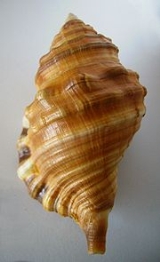
Cymatium parthenopeum
Encyclopedia
Monoplex parthenopeus, common name
the hairy trumpet, also known as Monoplex parthenopeus, is a species
of predatory sea snail
, a marine
gastropod mollusk in the family
Ranellidae
, the triton snails, triton shells or tritons.
larvae remain in the plankton for nearly 300 days, dispersing as far as 4000 km. This is the longest known larval duration and dispersal distance of any marine invertebrate which occurs along the west coast of North America.
Common name
A common name of a taxon or organism is a name in general use within a community; it is often contrasted with the scientific name for the same organism...
the hairy trumpet, also known as Monoplex parthenopeus, is a species
Species
In biology, a species is one of the basic units of biological classification and a taxonomic rank. A species is often defined as a group of organisms capable of interbreeding and producing fertile offspring. While in many cases this definition is adequate, more precise or differing measures are...
of predatory sea snail
Sea snail
Sea snail is a common name for those snails that normally live in saltwater, marine gastropod molluscs....
, a marine
Marine (ocean)
Marine is an umbrella term. As an adjective it is usually applicable to things relating to the sea or ocean, such as marine biology, marine ecology and marine geology...
gastropod mollusk in the family
Family (biology)
In biological classification, family is* a taxonomic rank. Other well-known ranks are life, domain, kingdom, phylum, class, order, genus, and species, with family fitting between order and genus. As for the other well-known ranks, there is the option of an immediately lower rank, indicated by the...
Ranellidae
Ranellidae
Ranellidae, common name the triton shells or tritons, is a taxonomic family of small to very large predatory sea snails, marine gastropod mollusks in the clade Littorinimorpha.-Subfamilies:...
, the triton snails, triton shells or tritons.
Distribution
This species occurs worldwide including:- The Western Atlantic OceanAtlantic OceanThe Atlantic Ocean is the second-largest of the world's oceanic divisions. With a total area of about , it covers approximately 20% of the Earth's surface and about 26% of its water surface area...
- New Zealand
Life cycle
Hairy trumpets are notable for having particularly long planktonic periods. The veligerVeliger
A veliger is the planktonic larva of many kinds of marine and freshwater gastropod molluscs, as well as most bivalve mollusks.- Description :...
larvae remain in the plankton for nearly 300 days, dispersing as far as 4000 km. This is the longest known larval duration and dispersal distance of any marine invertebrate which occurs along the west coast of North America.

